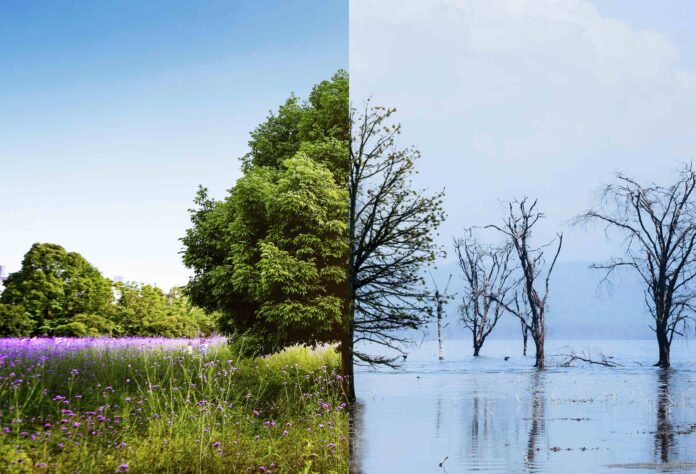Understanding Climate Change
Climate change is one of the most pressing issues facing our world today. The term climate refers to the long-term patterns of temperature, precipitation, wind, and other atmospheric conditions that define a region. These patterns can be affected by a wide range of factors, including natural processes like volcanic eruptions and solar radiation and human activities such as burning fossil fuels and deforestation.
The importance of understanding climate change cannot be overstated. Rising temperatures and changing weather patterns have far-reaching impacts on our planet’s ecosystems, economies, and communities.
From droughts and wildfires to sea level rise and more intense storms, we are already seeing the effects of global warming in many parts of the world. As such, it is vital that we all work together to address this issue head-on.
By learning about the science behind climate change, understanding its impacts on different regions and ecosystems around the world, and exploring potential solutions to mitigate its effects on our planet, we can all play a role in creating a more sustainable future for generations to come. So let’s dive in!
Exploring its Definition, Impacts on Counties, and Solutions for a Better Future
The Definition of Climate
Climate is often described as the average weather conditions in a certain area over a period of time. It is determined by several factors, including temperature, precipitation, humidity, wind patterns, and atmospheric pressure. These components can vary greatly depending on the location and time of year.
Temperature is perhaps one of the most important aspects of climate. It refers to the degree of hotness or coldness in a specific area at a given time.
In general, temperatures tend to be higher near the equator and lower towards the poles due to variations in solar radiation. Other factors that influence temperature include altitude, land elevation, and ocean currents.
Precipitation refers to any form of water that falls from the sky such as rain, snow, sleet or hail. The amount and frequency of precipitation can have a significant impact on ecosystems and environments around the world.
For example, areas with high precipitation may have lush forests while arid regions may have deserts. Wind patterns are also an important component of climate.
They are caused by differences in air pressure which can be influenced by various factors such as geography and proximity to large bodies of water. Wind patterns can influence temperatures by bringing warm or cold air masses into a region.
It should be noted that climate should not be confused with weather – which refers to short-term atmospheric conditions such as temperature changes or rainfall over hours or days rather than years – although these two concepts are related. By understanding what climate means we can begin to appreciate how it affects our daily lives and how human activities contribute to its change over time.
Affected Counties
Coastal Areas: The Frontline of Climate Change
Coastal regions are among the most vulnerable to the impacts of climate change. Rising sea levels, more frequent and intense storms, and other climate-related factors threaten to erode shorelines, flood homes and communities, and displace millions of people worldwide.
According to recent estimates from the European Environment Agency, around 200 million people could be affected by sea-level rise by 2100 if greenhouse gas emissions are not reduced. In the United States alone, coastal areas account for over 40% of the population and generate more than $8 trillion in economic activity annually.
Hurricanes like Hurricane Katrina in 2005 and Hurricane Harvey in 2017 have already demonstrated how devastating these events can be for coastal communities. Sea level rise is also causing shoreline erosion and loss of wetlands that provide natural protections against storm surges.
The Arctic: Melting at an Unprecedented Rate
The Arctic region is particularly vulnerable to climate change due to its unique geography, which makes it highly sensitive to even small changes in temperature. Over the past few decades, temperatures in the Arctic have risen twice as fast as the global average, leading to rapid melting of sea ice and permafrost.
This melting has far-reaching consequences for both human societies and natural ecosystems. The loss of sea ice threatens iconic species like polar bears that rely on this habitat for hunting.
It also opens up new shipping routes through previously inaccessible northern waters that will have significant economic implications across industries including tourism, fishing and oil exploration. The thawing permafrost also poses a major threat as it releases methane – a potent greenhouse gas – into the atmosphere which further exacerbates climate change by trapping heat in our atmosphere at alarming rates.
Climate Refugees: Displacement & Migration
As the impacts of climate change continue to intensify, they are likely to force millions of people to flee their homes and seek refuge in other parts of the world. Some of these will be displaced by extreme weather events like hurricanes or flooding, while others may lose their livelihoods due to changes in weather patterns or sea-level rise. This displacement can cause major social, political and economic upheavals, as well as posing significant challenges for human rights and international law.
According to a report by the Internal Displacement Monitoring Centre, around 17 million people were displaced by climate-related disasters in 2018 alone. This number is expected to rise dramatically over the coming decades unless action is taken urgently.
It’s clear that climate change poses serious threats that go beyond just environmental concerns but also lead to social and economic upheavals. Both developed and developing countries must work together towards sustainable solutions that reduce carbon emissions while increasing resilience against future effects of climate change.
Solutions to Combat Climate Change
The reality is that human activities are the primary cause of climate change. However, we can still take action to slow down and eventually reverse the damage that has already been done. Here are some solutions:
Rapidly transition to Renewable Energy Sources
Energy consumption is one of the most significant contributors to carbon emissions. By transitioning from fossil fuel-based energy sources to renewable ones such as wind, solar, hydro, and geothermal energy, we can significantly reduce our carbon footprint.
Renewable energy technologies have become increasingly more affordable and accessible over the years. As a result, many countries have set ambitious targets for transitioning their economies away from fossil fuels.
Carbon Capture Technology
One way of reducing excess carbon dioxide in the atmosphere is through carbon capture technology. This technology involves capturing CO2 emissions at their source (power plants or industrial facilities) before they are released into the atmosphere and then storing them in geological formations under the Earth’s surface. It’s a promising solution as it allows us to continue using fossil fuels while reducing their environmental impact.
The Importance of Individual Actions
While individual actions may seem small in comparison to global emissions from industry and transportation sectors, they still play a crucial role in preventing climate change. We all have a responsibility to make changes in our daily lives such as choosing sustainable modes of transportation (biking or public transit), consuming less meat products (which have high carbon footprints), reducing water waste etc.. These simple steps collectively make a significant impact on our planet’s health and sustainability.
Overall, implementing these solutions requires combined efforts from governments, industries, communities and individuals. We must work hand-in-hand towards achieving our common goal for a sustainable future.
Historical Climate Change
Have you ever wondered how the Earth’s climate has changed over time? Well, it turns out that the Earth’s climate has been in a constant state of flux since its formation.
However, in recent times, human activities have accelerated these changes. Historically, various natural causes such as volcanic eruptions and solar radiation have also played a role in altering the climate.
Volcanic eruptions are one such cause. These eruptions spew gases and particles into the atmosphere which can block incoming sunlight and cool the Earth’s surface.
On the other hand, solar radiation is another factor that affects our planet’s temperature. The Sun emits varying amounts of energy over time which can result in fluctuations in temperature on Earth.
Overall, understanding historical climate change is important because it helps us to contextualize current changes and determine their causes. By recognizing natural events that have influenced our planet’s climate throughout history, we can better predict future changes and develop effective strategies to mitigate them.
Climate Change Effects on Biodiversity
Biodiversity refers to the variety of living organisms existing on our planet. Unfortunately, as a result of human-induced climate change, biodiversity is being threatened at an unprecedented rate. Changes in temperature and precipitation patterns are causing habitat loss and species migration around the world.
For example, warmer temperatures are causing sea levels to rise which is leading to land erosion and flooding habitats for coastal plants and animals alike. Additionally, shifts in precipitation patterns are making certain areas too dry or too wet for species to survive.
The importance of biodiversity cannot be overstated; it plays a critical role in maintaining functioning ecosystems that provide us with essential services such as food production and clean water supplies. Therefore, protecting biodiversity from the impacts of climate change should be a top priority if we want to ensure continued prosperity for ourselves as well as all other living beings on this planet.
The Role of Clouds in Climate Change
Did you know that clouds can both exacerbate or mitigate global warming effects? It’s true, and the reason behind it is quite fascinating.
On one hand, high-altitude clouds can trap heat radiating from the Earth’s surface, leading to a warming effect. On the other hand, low-altitude clouds can reflect sunlight back into space and have a cooling effect.
The exact impact of clouds on climate change is still being studied by scientists, but one thing is clear: they play an important role in regulating our planet’s temperature. As we continue to explore solutions for mitigating climate change, cloud manipulation may become an area of focus.
For example, some researchers are exploring ways to increase the formation of low-altitude clouds above oceans as a way to reflect more sunlight back into space and cool the planet. While this technology is still in its early stages, it highlights the importance of understanding even small details like cloud formation in mitigating our planet’s changing climate.
Conclusion
Climate change is one of the most pressing issues facing humanity today. However, by understanding historical climate changes and its impacts on biodiversity as well as smaller details such as cloud formation we can work towards solutions that mitigate its effects.
While it may seem daunting at times, there are reasons for optimism – technological advancements and increased public awareness about climate change have already begun to lead to positive changes around the world. By working together we can create a sustainable future for ourselves and generations to come.



